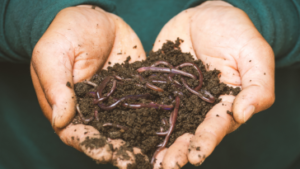Compost can be used to improve the soil structure and drainage, as a mulch to cut down on water loss, and as a fertiliser to improve the soil’s fertility.
Soil improvement
In the beginning of spring, it is useful to dig in a layer of compost into the soil. The amount of compost available is the only limiting factor. Planting new trees, shrubs, and nursery seedlings with half compost and half soil provides a particularly good growing medium with sufficient nutrients.
Lawn growth can be much improved if you dig in a layer of compost into the soil before planting and replacing dead spots in the lawn.
Top dressing

Compost serves as an excellent nutrient source when used as top dressing on lawns and around the trunks of trees and stems of plants. When irrigating on the lawn or plants, the nutrients leach into the soil and improves plant growth. The compost can be sifted before it is applied to remove unattractive pieces or not fully decomposed materials.
Compost as mulch
Mulching with compost is much the same as top dressing. The layer of compost is spread around the trunks of trees and stems of plants. This can be done in late spring to keep the moisture from evaporating in the hot summer months. Mulching also protects the soil against erosion and the drying effect of the wind. Nutrient’s leak into the soil and are absorbed by the soil by further decomposition of the compost.
Potting soil
When sterilised, compost can be mixed with soil in a 50/50 ratio and can be used for potting, window boxes and hanging baskets.
Compost as tea
By putting compost in a flour bag or similar bag and letting it soak in a pail or drum of water, you can make compost tea. Compost tea is a tidy way of giving nutrients to houseplants or to spot fertilize nursery seedlings. The compost should soak in the water until the water is tea coloured.
The compost remains in the bag and can be used for mulch or can be worked into the soil.
Different composting systems that can be considered:
One bin system
For composting small amounts of materials, a one bin system is ideal. The recommended minimum size is 1 cubic metre, otherwise the compost will not build up heat sufficiently. One bin may not be enough when you want to make a lot of compost. Building material can consist of lumber, timber blocks, steel posts and wire fencing or free wooden pallets from local businesses.
If you do not have enough composting material to fill the bin at once you can build the heap over time. When there is finished compost at the bottom, just remove the unfinished compost, get the useable compost out and replace the unfinished compost.
Two and three bin system
The same type of materials used to build a one bin system may be used to build this system. The advantage of a two or three bin system is that you can have a complete compost heap and a heap in progress, almost like a storage system. Turning can take place by moving the contents of one bin to another, thus improving aeration and mixing considerably. The three-bin system is normally used to store finished compost in one, have one finished composting heap and one in progress.
Rotating or tumbling system
Composting in such a system is relatively faster than other systems, but only small amounts can be composted, and the system can be very expensive. The compost can be ready in as quick as three weeks if the process is handled correctly. When you fill the container, make sure that you don’t fill it to the top, otherwise the materials won’t mix, and decomposition may be slowed down.
When the drum is partially filled with 50/50 wet “greens” and “browns” give the drum a good turn so that the materials can mix properly. Thereafter, give the drum a good turn every day for mixing and improving aeration. The next batch of materials can be collected and stored ready for composting. Due to the high temperature reached and good aeration, microbe activity is high and composting quick.
Trench composting
Composting can be done exactly the same as bin composting by digging a trench or two or three and following the same procedure as bin composting. The trench must be at least one cubic metre in size.
Worm composting

Worm composting is ideal for composting food wastes but should be done in a sealed container to contain odours and keep out rodents and pets. The compost must stay cool and may not heat up, as it would kill the worms. Normal compost material can be used if it is very loose (aerated) to allow the worms to move freely in the heap. This method is not advised, because of the intensity thereof.
We thank the Agricultural Research Council (ARC) of South Africa for the material they provided for the readers of ProagriMedia. For more information visit their website www.arc.agric.za.









